The following deviations from the rules apply:
If you get new dice, you don't have to roll them immediately. Those dice just get an undefined value and you may roll them at any given time. As soon as you finish your turn
all dice not yet rolled will be rolled automatically.
This way most of the actions may be undone.
When building a province tile the next province tile will not be revealed automatically but only on demand (or at the end of the turn).
Original rules state that the player with the lowest initial dice value becomes starting player. The implementation uses the reverse strategy: the dice for each kali statue are rolled and then the kali statues are assigned
according to the player order, i.e. the starting player gets the kali statue with the lowest value and so on.
You may skip a river movement using the river action (harbor), i.e. if you give up a dice with value 1 for example you may move 1 free space or none at all.
The “Kali statue” boards are reduced to the hands only, indicating free spaces at the player info.
Rajas of the Ganges
→ original rules (pdf)
India in the era of the aspiring Mogul empire. New lands are being gained along with great prosperity attained through the trading of silk, tea, and
spices. Imposing structures such as the Taj Mahal and the Red Fort are built, and gorgeous gardens are created alongside new buildings and parks
that will impress generations to come even centuries later
At a time when the empire has almost reached its greatest dimensions and is in a phase of relative stability, players, representing rajas and ranis,
are called upon to live up to the requirements of their role as venerable sovereigns. They must improve their estates into magnificent and wealthy
provinces. Keeping in mind the important role of karma, players balance their growth in a demanding interplay of prestige and prosperity. The one
with the most successful outcome will truly become one of the nation’s legendary leaders.
Game Components
1
gameboard
4
4
“Kali statue” boards
64
province tiles (16 per color)
48
dice (12 per color)
24
workers (6 per color)
4
boats (1 per color)
4
money markers (1 per color)
4
fame markers (1 per color)
20
cubes (5 per color: 4x upgrade and 1x karma)
4
bonus markers for the money track
1
starting player elephant
2
cover tiles (for the 3-player game)
30
yield tiles (8 in white, 9 in yellow, 6 in red, 7 in brown) for Navaratnas version
8
river tiles (Ganga module)
Object of the game
The fame track and the money track run parallel to each other
in opposite directions.
The first player to have his fame
marker and his money marker converge or even pass each other on their tracks, has a
good chance to win.
Your task is to develop your province with the help of your workers and the clever use
of your accumulated dice. In the end, you must win the race with a combination
of wealth and fame. The fame track and the money track run parallel to each other
in opposite directions around the gameboard. The fame markers are moved clockwise,
the money markers, counter-clockwise.
As you build and expand, you attempt to increase both your fame and wealth so that
your fame marker and your money marker intersect. The first player to have his fame
marker and his money marker converge or even pass each other on their tracks, has a
good chance to win.
Course of the game
Players, in turn, place one worker, pay the costs if required, and immediately
carry out the associated action. This continues until nobody can place a worker
any more. After that, each player takes his workers back, and a new round
begins.
The game proceeds over several rounds, each of which consists of several
stages. In each stage, players, in turn – in clockwise order, beginning with the
starting player – place one worker, pay the costs if required, and immediately
carry out the associated action. This continues until nobody can place a worker
any more. After that, each player takes his workers back, and a new round
begins.
Workers can be placed in the following areas on the gameboard:
-
At the quarry, in order to carry out building actions on your
province board.
-
At the market place, in order to receive money through
market scorings later in the game.
-
In the Great Mogul’s palace, in order to get various benefits
there.
-
At the harbor, in order to advance on the river and thus reach
lucrative river spaces.
At the quarry and at the harbor, workers are always placed row by row from
left to right. At the market place and in the palace, you can choose any
(unoccupied) action space.
While advancing on the fame and money tracks and developing your province
board, you will have chances to obtain valuable bonuses.
Placing workers and carrying out the associated actions
The placement of workers always proceeds in this order:
-
Place a worker
-
Pay costs if required: give up money and/or dice
-
Carry out the action
If you have to pay money and/or dice for an action you can't carry out that action if you are short of money or suitable dice.
On each action space there may be only one worker.
You may store only as many dice as Kali has free hands, i.e. a maximum of 10 dice in the basic game. If you get more dice, you either take
fewer dice or put dice from your Kali statue back into the general supply
before taking new ones.
If a die color is temporarily unavailable
in the supply, you can’t take this color
at that moment.
The placement of workers always proceeds in this order:
-
Place a worker
-
Pay costs, if required: give up money and/or dice
-
Carry out the action
Costs: Depending on what action space you place a worker on, you might have
to pay costs for being allowed to carry out the applicable action. Some spaces
are for free; for others, you have to give up dice or money. How much it costs
to place a worker on an action space is shown on the action space itself.
Pay money for an action: Every time you have to pay money for an
action (e.g., at the harbor or the quarry), you move your money marker
back on the money track accordingly – 1 space for each money you
have to pay. If your marker is sitting on 0, you have no money left and
temporarily cannot carry out any actions that cost money.
The same applies to actions for which you have to pay dice – if you
don’t have any (suitable) dice, you can’t carry out the applicable action.
On each action space there may be only one worker. Dice are never placed
onto the board, but always into the (general or personal) supply!
Dice are the most important resource in this game.
Whenever you get a die from the general supply, you
roll it immediately and, with the rolled number facing
up, add it to your own supply, i.e. on your Kali statue. The
value of the die conforms to the number rolled (from 1 to 6).
Attention! You may store only as many dice as Kali has free hands –
that means, in the basic game you may own a maximum of 10 dice.
If you get into a situation that would get you more dice, you either take
fewer dice or put dice from your Kali statue back into the general supply
before taking new ones.
If a die color is temporarily unavailable
in the supply, you can’t take this color
at that moment.
Building action (quarry)
Place a province tile in your province and get fame
points and/or money for this
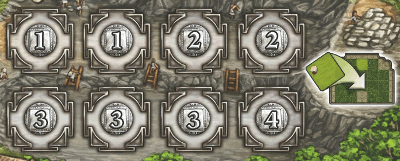
Quarry for 3 or 4 players. With 3 players the first space with value 1 is covered and not available.
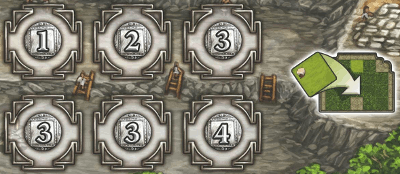
Quarry for 2 players.
In order to develop your province, you need to send workers into the quarry. Depending on the space, you pay 1 to 4 money on the
money track. In return, you acquire one of the 12 province tiles on open display. On the top left of the tiles you can see what dice with which total minimum value
you have to give up in order to take the tile. You are allowed to overpay.
Once you
acquire a province tile, you immediately have to place it onto your province board.
In order to develop your province, you need to send workers into the quarry.
Depending on the space where you place the worker, you pay 1 to 4 money on the
money track. In return, you acquire one of the 12 province tiles on open display.
On the top left of the tiles you can see what dice with which total minimum value
you have to give up in order to take the tile. Put dice of the respective color back
into the supply. Their total value has to be at least as high as the one shown on
the tile. When building, you are allowed to overpay. That means: In order to acquire
a tile with the value “blue 7,“ you can pay with a blue 3 and a blue 5, for example.
Besides the costs, the tiles also depict roads, buildings and/or markets. Once you
acquire a province tile, you immediately have to place it onto your province board.
The province boards
Province tiles acquired at the quarry are immediately placed on your province board.
Each tile has to be connected to the
residence through at least one road.
You may cut off a road of an adjacent tile; it is sufficient that each tile is connected to the
residence through at least one road.
When adding a tile with markets to your province, you
immediately receive the amount of money indicated on that tile. When
you add a tile with buildings, you immediately receive the corresponding fame points for those buildings.
Special yields:
You get the yields printed on the edge of the province
boards immediately when you have connected them
to your residence via a road, after scoring for the province tile
itself.
Special yields don't have to be connected.
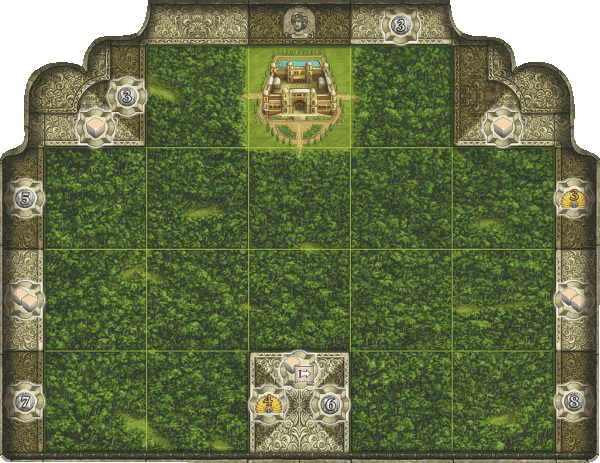
The province board shows the
territory that you, being a raja,
control and strive to expand. Your
residence is in the middle on the
top; from there, 3 roads lead into
the country. Every time you add a
new province tile, the end of one
of its roads has to connect to an
already-existing road, so that there is a connection to the residence.
You can turn the new tile in any direction. You may also orient a tile in
such a way that it cuts off a road of an adjacent tile; not all road ends
need to be connected – it is sufficient that each tile is connected to the
residence through at least one road. Once placed, the tiles cannot be
relocated later on. Be careful not to cut off all roads, so that you always
have good possibilities for placing a tile.
When you have added a new tile to your province, you immediately score
money and/or fame for it. Some tiles show one or two market tents with
certain goods (silk, tea, or spices) of a certain value; other tiles show one
or two buildings (temple, palace, fort, or mill); and a few tiles show a
combination of both.
When you add a tile with one or two markets to your province, you
immediately receive the amount of money indicated on that tile. When
you add a tile with one or two buildings, you immediately receive 2, 3,
or 4 fame points for each building, depending on where your upgrade
cube is on the scroll for the corresponding building on the gameboard (see also Upgrades of the buildings).
Special yields:
There are yields printed on the edge of the province
boards (symbolically, for special gains due to trade relations you have
established). You get these immediately when you have connected them
to your residence via a road, after scoring for the province tile
itself.
Of course, it is also possible to place a tile without creating a connection to
the special yield. In this case, you don’t get anything extra.
Market action (market place)
Collect money for certain markets in your province
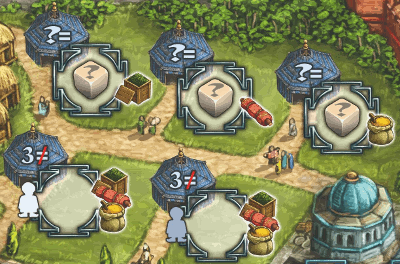
Market for 3 and 4 player. A single player may not occupy both spaces for assorted goods.
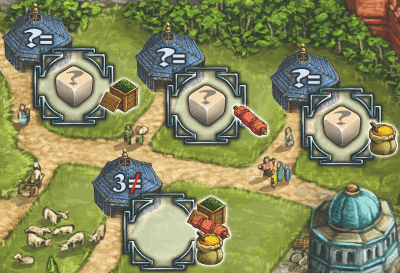
Market for 2 players.
Workers on market spaces score for the markets on your province boards.
-
Assorted goods – score for exactly one market per kind of good.
-
Goods of one kind – give up any one die and score for up
to a maximum of as many markets of one kind of
good as corresponds to the value of the die.
You may place only one of your
workers on the assorted goods market in a round.
Every time you send a worker to one
of the market spaces, you generate
income for the markets laid out in
your province. There are markets with
3 kinds of goods:

Silk

Tea

Spices
There are 2 types of market spaces:
-
Assorted goods –when you place a worker here, you
may score for exactly one market per kind of good.
-
Goods of one kind – when you place a worker here, you
have to give up any one die. Then you may score for up
to a maximum of as many markets of one kind of
good as corresponds to the value of the die.
Attention! In the 3- or 4-player game, you may place only one of your
workers on the assorted goods market in a round; that means, if you
have placed a worker on the first space, the second space is no longer
available to you in this round. It can then only be used by another
player. However, you still have the possibility to place workers on the
other market type.
Actions at the palace
Give up a die, if required, and get a benefit
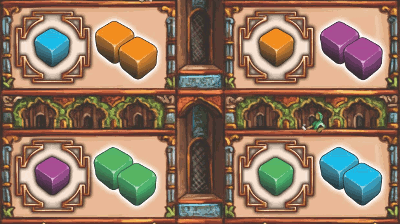
Give up 1 die of a specific color
and get 2 dice of a different
color.

Take 2 money. You may also reroll as many
of your dice as you want.
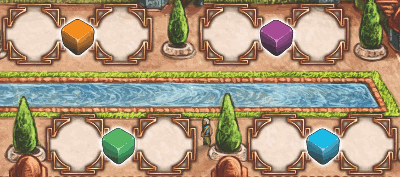
The terrace with 3 and 4 player: take 1 die of the
applicable color
from the supply.
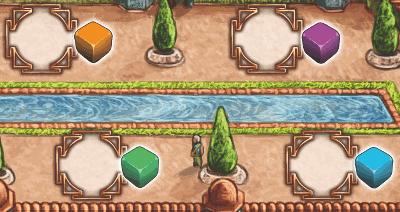
The terrace with 2 players: take 1 die of the
applicable color
from the supply.
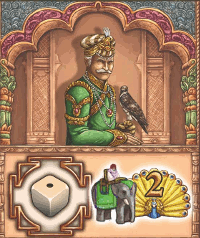
Great Mogul: Give up one die showing a “1.“
In return,
you get 2 fame points and become the starting player in the
next round.

Dancer: Give up one die showing a “2.“
In return, you take
any 2 dice from the supply and draw a face-down white yield
tile. You immediately earn the yield of the tile (1 die, 3 money,
1 upgrade, or 1 karma).
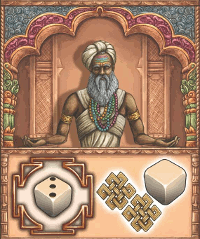
Yogi: Give up one die showing a “3.”
In return, you get
2 karma and 1 die of your choice.
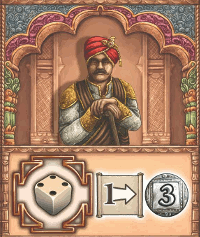
Raja Man Singh: Give up
one die showing a “4.”
In
return, you upgrade a building
type of your choice and earn
3 money.
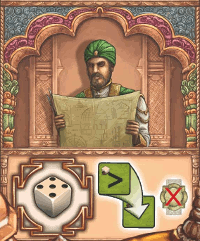
Master builder: Give up one die showing a “5.”
Cover any
tile in your province with another one from the supply.
Important:
- The new tile has to be more expensive than theold one.
-
Pay the difference by giving up 1 (or more) dice
in the color of the new tile.
-
All tiles
still need to have a connection to the residence.
-
You do not receive any special yield
again.
- You may cover every province tile only once.
-
You cannot
use the master builder if you have no matching tiles or dice.
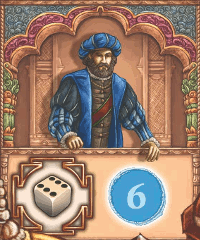
Portuguese: Give up one die showing a “6.”.
In return, you
advance exactly 6 unoccupied spaces on the river and get the
applicable earnings.
Attention: When you have advanced to the last 6 spaces on
the river, you may not use the Portuguese anymore.
River action (harbor)
Give up a die showing a 1, 2, or 3 and advance up to three
unoccupied spaces on the river
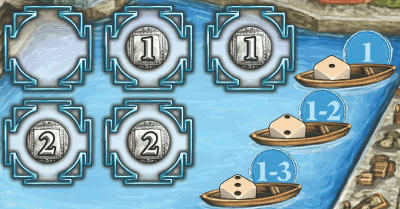
Harbor for 3 and 4 players. With 3 players the right space with value 1 is covered and not available.
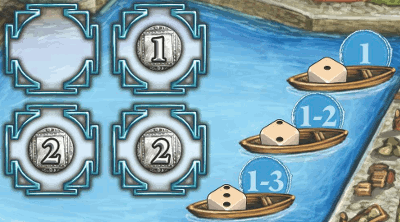
Harbor for 2 players.
Placing workers in the harbor cost
0, 1 or 2 money.
The river action can be used only if you give up a
“1,” “2,” or “3”.
According to the value of the die you may advance a maximum of unoccupied spaces (max 3!).
Spaces
occupied by other players’ boats are not included in the count but are skipped.
Multiple boats are allowed to rest only on the starting space and the final river space.
You immediately get the earnings of the space where you stop your boat.
The river action can be used only if you give up a
“1,” “2,” or “3”.
Every time you place a worker at the
harbor, you may advance your boat up
to three unoccupied spaces on the river,
depending on the number on the die you
have given up. The harbor provides space
for several workers. The first worker placed
here doesn’t cost anything; workers placed
later cost 1 or 2 money.
If you give up a die showing a “1,” you advance exactly one unoccupied
space; if you give up a “2,” you advance one or two unoccupied spaces; if
you give up a “3,” you may advance up to three unoccupied spaces. Spaces
occupied by other players’ boats are not included in the count but are skipped.
So there can never be more than one boat on any particular river space.
The only exceptions to this are the starting space and the final river space
where multiple boats may rest.
You immediately get the earnings of the space where you stop your boat.
When you have arrived at the final river space, you can no longer use the
river action.
The possible earnings on the river are listed in the appendix.
The upgrades of the buildings
The 4 types of buildings that you
can erect in your province are shown
on the gameboard. The upgrade cubes show how may fame points you earn when you add a province tile with that building to your province board.
 enable you to upgrade any building.
enable you to upgrade any building.
The 4 types of buildings that you
can erect in your province are shown
on the gameboard. At the beginning
of the game, your upgrade cubes lie
on the first level of each building –
i.e., you earn 2 fame points when you
add a province tile with 1 building (or,
likewise, 4 fame points for 2 buildings).
 Upgrades enable you to improve
your constructional skills and to earn
3 (or 4) points for a certain building
type in later building actions.
Upgrades enable you to improve
your constructional skills and to earn
3 (or 4) points for a certain building
type in later building actions.
Karma
Give up 1 karma  and turn a die to the number on the opposite side
and turn a die to the number on the opposite side
One karma allows you
to turn any die on your Kali statue to the opposite side when you use it.
You may have a maximum of 3 karma.
You can influence the result of a die roll through karma. One karma allows you
to turn any die on your Kali statue to the opposite side when you use it;
that means a “1” can turn into a “6” and vice versa, a “2” into a “5,” etc.
You start the game with karma at
level 1. Over the course of the game,
you can improve your karma – for
instance, by sending a worker to
the Yogi in the palace (see p. 18,
“The Chambers” “Yogi”) or by
stopping your boat on the applicable
river space.
Besides this, there is a bonus space on the fame track (space 24) that increases
your karma 2 levels if your fame marker stops on that space or crosses it. The
highest karma level is 3; that means you may have a maximum of 3 karma.
In order to use karma, you don’t have to place any worker – you may use
your karma anytime during your turn when giving up a die. For each karma
you use, you move your karma cube 1 level down. So the karma can even go
down to zero.
Get new workers
Move forward on the scoring tracks or on the river and receive
more workers
Each player starts with 3 active
workers.
If you have advanced far enough on the respective
scoring tracks or on the
river you receive extra workers.
Important: you may only get 2 extra workers in the base game.
At the beginning of the game, each player has 3 active
workers at his disposal.
During the course of the game, you can get up to 2 additional
workers. If you have advanced far enough on the respective
scoring tracks (money: space 20; fame: space 15) or on the
river (bridge), you receive extra workers.
Important: As soon as you have received your second inactive
worker (no matter whether on one of the tracks or the river), you
immediately take your extra one off the board and remove him
from the game.
The fame and the money tracks as well as the river
each have one space with an inactive worker per player
color. The spaces on the scoring tracks with the inactive
workers are regular spaces; at the moment when your
money marker or fame marker stops on the respective
space or crosses it, you take the worker of your color.
With this, he becomes active. The inactive worker on the
river doesn’t have his own river space (the bridge doesn’t
count as a river space); that means, when your boat has
passed the bridge, you take the worker of your color.
You never lose a worker once you have activated him this way, even if your
marker falls back (which can happen only on the money track). You can place a
new worker even in the same round in which you have obtained him.
Bonuses on the scoring tracks
Arrive at the space and receive the bonus
Besides the inactive workers, the two scoring tracks also have special spaces;
when you reach or cross them, you immediately get the corresponding bonus.
The fame track has 3 bonus spaces:
-
 Space 5: You receive an upgrade of a building type of your
choice.
Space 5: You receive an upgrade of a building type of your
choice.
-
 Space 24: You may increase your karma 2 levels
Space 24: You may increase your karma 2 levels
-
 Space 31: You may move your boat to the next unoccupied
river space and get the applicable earnings.
Space 31: You may move your boat to the next unoccupied
river space and get the applicable earnings.
The money track has 4 bonus spaces:
-
 Spaces 12 and 44: You may move your boat to the next
unoccupied river space and get the applicable earnings.
Spaces 12 and 44: You may move your boat to the next
unoccupied river space and get the applicable earnings.
-
 Spaces 33 and 55: You may take any 2 dice from the supply,
roll them, and put them on your Kali statue.
Spaces 33 and 55: You may take any 2 dice from the supply,
roll them, and put them on your Kali statue.
Since you pay money and can thus fall back on the money track,
there is a special bonus marker of your color that indicates
which bonus you’ll get next on the money track.
Besides the inactive workers, the two scoring tracks also have special spaces;
when you reach or cross them, you immediately get the corresponding bonus.
The fame track has 3 bonus spaces:
-
 Space 5: You receive an upgrade of a building type of your
choice. (This upgrade counts from your next turn on.)
Space 5: You receive an upgrade of a building type of your
choice. (This upgrade counts from your next turn on.)
-
 Space 24: You may increase your karma 2 levels
Space 24: You may increase your karma 2 levels
-
 Space 31: You may move your boat to the next unoccupied
river space and get the applicable earnings.
Space 31: You may move your boat to the next unoccupied
river space and get the applicable earnings.
The money track has 4 bonus spaces:
-
 Spaces 12 and 44: You may move your boat to the next
unoccupied river space and get the applicable earnings.
Spaces 12 and 44: You may move your boat to the next
unoccupied river space and get the applicable earnings.
-
 Spaces 33 and 55: You may take any 2 dice from the supply,
roll them, and put them on your Kali statue.
Spaces 33 and 55: You may take any 2 dice from the supply,
roll them, and put them on your Kali statue.
Since you pay money and can thus fall back on the money track,
there is a special bonus marker of your color that indicates
which bonus you’ll get next on the money track. When you
reach or cross space 12 for the first time and get the applicable
bonus, you take the marker of your color, turn it over and put
it on space 33 (die side facing up). When your money marker
reaches or crosses this space as well, you turn the marker back
and put it on space 44 (river space side facing up), etc. After
you have crossed the last bonus space on the money track, you
remove your marker from the game.
Attention! A bonus applies only to the track where it is printed. If, for
example, your money marker passes a bonus space printed on the adjoining
fame track, you don’t get the bonus from there, of course.
End of a round
When no player has any worker left, the round ends.
If one of the
players has placed a worker at the Great Mogul, he becomes the starting player
of the following round.
Otherwise the starting player
elephant goes from the previous starting player clockwise to the next player.
All players take back their active workers. The starting player begins the new round.
After you have placed all of your active workers and carried
out the applicable actions, the round ends.
If one of the
players has placed a worker at the Great Mogul, he now gets
the starting player elephant and becomes the starting player
of the following round. If nobody has sent a worker to the Great Mogul, the
elephant goes from the previous starting player clockwise to the next player.
All players take all their active workers off the gameboard and put them back
below their Kali statue. After that, the starting player begins the new round.
End of the game
As soon as one player manages to have his fame marker and his money
marker converge or pass each other, the end of the game is triggered.
The
current stage will be completed, i.e. all players who are sitting between
the player who has triggered the end of the game and the current starting
player may place one more worker.
If there are two or more players whose
markers passed each other on their final turn, the player with the greater difference between the 2 markers is the winner.
In case of a tie, the
first player whose two markers passed each other wins.
As soon as one player manages to have his fame marker and his money
marker converge or pass each other, the end of the game is triggered. The
current stage will still be completed – i.e., all players who are sitting between
the player who has triggered the end of the game and the current starting
player still have a chance to win and may place one more worker (provided
they have any left) and carry out the applicable action.
After that, players check who has won. If there are two or more players whose
markers passed each other on their final turn, each of the players involved
counts the difference of fame points between his money marker and his fame
marker; the player with the most points wins the game. In case of a tie, the
first player whose two markers passed each other wins.
To find out who is second and third, etc., count the number of fame points
that are still separating your fame marker from your money marker.
There are 2 spaces on the money track belonging to each space of the fame track.
Both spaces are equivalent in regard of the end scoring.
Notes
In order to develop your province successfully and to win the race, you
primarily need money, dice, and workers. It is important to make sure that
you don’t run out of dice or of money and don’t have to make do with fewer
workers than the other players for too long.
Gain additional workers by advancing on the two scoring tracks and on the
river.
Generate money primarily through markets; build them in your province and
use workers to activate them. Additionally, bonuses on your province board,
on the river, and from the raja in the palace are good sources of money.
Such bonus spaces can get you extra dice as well. The palace also provides
opportunities to obtain and exchange individual dice.
To fulfill the winning conditions, you need to establish a well thought-out road
network within your province and gain as many special yields as possible. To
this end, you will use the building action on the gameboard, for which you pay
money and dice. Buildings in your province give you fame points; markets give
you money.
Variants
Navaratnas Version
Play with 6 workers, 8 dice, and upgraded special yields
You can activate all 3 inactive workers.
You play with the back of your Kali statue (max. 8 dice) and the back of your province board.
You can improve the yields printed on the province board with the colored yield tiles. You can get those:
-
when the game starts:
Each player gets a random brown yield tile and puts it on one of the two possible spaces on his
province board.
-
when you are at the dancer:
Instead of drawing a white yield tile, you now choose any yield tile on display and put it on your province board.
Different from the basic game, here you earn the yield not immediately but
only when you have connected the yield tile to a road on your province
board.
-
when you have fewer active workers than other players
If it is your turn but you are out of workers, you can choose any yield tile and put it on your province board.
You may not move or cover yield tiles already placed on the board.
You may refrain from taking a yield tile.
After having played the basic version for one or more games, you can opt
for the “Navaratnas“ version for advanced players (English “The Nine
Gems“). Here, the following
modifications apply:
You can activate all 3 inactive workers.
So you may play with up to 6 workers.
You play with the back of your Kali statue
and you may store only up to 8 dice.
You play on the back of your province board.
Here also, special yields are printed on the edge of
the province board, which you can connect to your
road network. However, these are only minor yields,
but you can improve them during the course of the
game.
At the beginning of the game, mix the brown yield
tiles. Each player randomly picks one, reveals it and
puts it on one of the two possible spaces on his
province board. You decide which of the special yields
on the board you wish to cover.
Now place the remaining brown yield tiles
as well as all other yield tiles face up on
the buildings of the same color on the
gameboard. You may get them during the
game to enhance the special yield you can
get from your province board.
Attention: Always score for the province tile first before you take the special
yield. You may not move or cover yield tiles already placed on the board.
You may not move or cover yield tiles already placed on the board.
You may only take yield tiles in a color for which you still have
space available on your board.
You may also refrain from taking a yield tile.
There are 2 ways to obtain additional yield tiles during the game:
-
When you are at the dancer
Every time you place a worker at the dancer and give up one value-2
die of any color, you may take 2 dice of your choice from the supply and
choose any yield tile. You immediately put this tile face up on an (as yet)
unoccupied space of the corresponding color on your province board.
Different from the basic game, here you earn the yield not immediately but
only when you have connected the yield tile to a road on your province
board.
-
When you have fewer active workers than other players
If, for example, you have a total of 4 active workers, but at least one of
the other players already has 5 workers at his disposal, you get 1 yield tile
in the fifth stage of the current round if it were your turn to place a worker
but you don’t have any left. You immediately decide on which unoccupied
space of your board you want to place the new yield tile (face up and
color-matching).
If at least one other player even has 2 more active workers than you, you take
another yield tile and place it as if it were your turn to place a worker but you
can’t place any for the second time.
The brown yield tiles
1 fame point for each tile
in your province that has
at least 1 market
1 fame point for every
3 river spaces you
have advanced so far
(the starting space
doesn’t count)
1 money per building
in your province
2 money for each
yield tile you
have connected
2 fame points for
each bend that
you have built in
your province
2 money per
upgrade you have
made so far
1 fame point
for each active
worker you have
For Mixed Player Groups
Advanced players use the Navaratnas side of their
board with minor yields and the back of their Kali statue (max 8 dice).
You can have up to 5 workers.
You cannot improve the special yields on your province board.
The dancer provides you with a randomly drawn white yield to use immediately.
For advanced players who play with a group that includes beginners, it is also
possible to play with handicaps.
In this case, the advanced players use the Navaratnas side of their
board and the back of their Kali statue, whereas the beginners use the basic
side of their board and the front of their Kali statue.
You can have up to 5 workers.
The yellow, red, and brown yield tiles stay in the
box. You play according to the basic rules and use only the white yield tiles for
which you get a yield only at the dancer (as in the basic game) to
use immediately.
The Ganga Module
Modify river spaces using river tiles
Add the 8 river tiles to the game.
Use a die to determine the spaces for the river tiles.
For this version, you add the 8 river tiles to the game. They modify the river
earnings. At the beginning of the game, shuffle the river tiles face down. Roll
a die, count the spaces, beginning with the first space after the starting space,
draw the first tile blindly and place it face up on the corresponding river space.
For example, if you roll a “2,“ you place the first river tile on the second space
and, in doing so, replace the 2 karma shown there.
Roll again, count the next spaces and place a tile until either you run out of
tiles or the river ends. The final space may never be covered by a river tile.
Return remaining river tiles to the game box.
Mango Village
→ original rules (pdf, german + english)
Now, the workers from the Ganges can also visit the village, picturesquely situated at the shores of
the river. The mango tree in the center of the village traditionally is the social and cultural meeting place of the village community. After you have built villages in
your province, a visit is worthwhile.
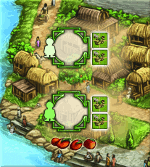
Mango Tree tile for the gameboard: front side for 3 or 4 players.
In the 3- or 4-player game, each player may send only one of his workers to the village per round.
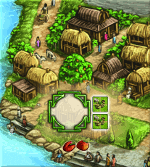
Mango Tree tile for the gameboard: back side for 2 players.
The 8 Mango Village province tiles can be acquired through the building action just as the other province tiles.
To acquire a Village tile, you
have to give up a double, i.e. two dice
showing the same values.
Each Mango Village tile, once placed, gives you a
special bonus depicted in the bottom right corner of the tile.
The
Mango Tree tile is placed on the corresponding space of the
gameboard providing 1-2 additional action spaces.
If you place a worker there,
you may score up to 2 of the villages in your province again.
Mix the 8 Mango Village province tiles and put them as a
face-up stack next to the other province tiles. The Mango
Village tiles can be acquired through the building action (just
as the other province tiles). They differ in their cost and yield,
though.
Cost: In order to acquire a Village tile, you
have to give up a double, i.e., two dice
showing the same values (e.g., two times a
“3”); the dice color does not matter in this case.
Yield: Each Mango Village tile, once placed, gives you a
special bonus depicted in the bottom right corner of the tile.
Put the Mango Tree tile on the corresponding space of the
gameboard.
Now there is also one action space (2 players) or two action
spaces (3 or 4 players) in the village on the Mango Tree tile. If you place a worker there,
you may score up to 2 of the villages in your province again.
If you have more than 2 villages in your province, you choose
which two you wish to score again.
In the 3- or 4-player game, each player may send only one of
his workers to the village per round.
Concerning the master builder: Mango villages can never be overbuilt. But you can place
these tiles on top of any other laid-out tile if you give up
another “5”.
For the Navaratnas variant: Mix the new yield tile with the brown yield tiles
at the beginning of the game.
Advance 3 spaces on the money track for each village in your province.
The player info

- starting player
- dice on the Kali statue
- empty spaces on the Kali statue
- current position on the fame track
- current position on the money track
-
current position of the bonus marker on the money track and type of bonus
-
number of fame points needed for the two markers to reach or pass each other
-
workers left (number of active workers in paranthesis)
-
summary of the markets on the province board. The values are sorted, so it is easy to see how much money a player can earn using a market action
-
thumbnail of the province board, so one can see which spaces are already occupied and how the road network looks like. Clicking that thumbnail will show the province board in the province display.
In the top left of each province tile in the supply the cost is displayed in an enlarged view. In the top right a small image shows the type of that tile (color and symbol) and the number of remaining tiles in the talon.
Clicking that image will show the tiles in that talon.
If a tile is taken, the next tile on display is chosen randomly.
Clicking

on the top right of the province tile display and the province board will show an enlarged vision of that item.
If a province tile hides another province tile on the province board because a player used the overbuilding action of the master builder,

is displayed in a corner of the topmost tile. Clicking that image will reveal the hidden tile.
The possible places for workers on the board each have a

nearby.
Clicking that image opens an info popup.
The earnings on the river have a

nearby.
Clicking that image opens an info popup.
The bonuses on the scoring tracks have a

nearby.
Clicking that image opens an info popup.
If you have to give up a die and there is only 1 applicable die, this die will be chosen automatically.
This does not apply if you have to use a karma for that die. In that case you have to explicitly confirm the selection to make clear that you will lose a karma.
Navaratnas version:
When you have chosen a yield tile, this yield tile will be displayed on the top left corner of your province board until you have selected a place for that tile.
Yield tiles on the province board have a  to separate them from the special yields printed on the board.
to separate them from the special yields printed on the board.